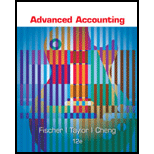
Advanced Accounting
12th Edition
ISBN: 9781305084858
Author: Paul M. Fischer, William J. Tayler, Rita H. Cheng
Publisher: Cengage Learning
expand_more
expand_more
format_list_bulleted
Question
Chapter 14, Problem 4.4E
To determine
Concept introduction
A procedure of paying off all the liabilities of the partnership firm, selling out all the respective assets of the partnership firm and then the distribution of the remaining assets and the cash when the partnership business is going out of the business is known as partnership liquidation.
The new capital when P was to sell one-half of his interest to the partnership for
Expert Solution & Answer
Want to see the full answer?
Check out a sample textbook solution
Students have asked these similar questions
General accounting
I am looking for help with this general accounting question using proper accounting standards.
Jacobson Pharmaceuticals manufactures an over-the-counter allergy medication called Breathe. Jacobson is trying to win market share from Sudafed and Tylenol. The company has developed several different Breathe products tailored to specific markets. For example, the company sells large commercial containers of 1,000 capsules to health-care facilities and travel packs of 20 capsules to shops in airports, train stations, and hotels.Jacobson's controller, Samatha Doody, has just returned from a conference on ABC. She asks Kris Yand, supervisor of the Breathe product line, to help her develop an ABC system. Doody and Yand identify the following activities, related costs, and cost allocation bases:Data Table
Activity
Estimated Indirect Activity Cost
Allocation Base
Estimated Quantity of Allocation Base
Materials Handling
$160,000
Kilos
16,000 Kilos
Packaging
$430,000
Machine Hours
2,500 Hours
Quality Assurance
$115,000
Samples
1,250 Samples
Total Indrect cost…
Chapter 14 Solutions
Advanced Accounting
Ch. 14 - Prob. 1UTICh. 14 - Prob. 2UTICh. 14 - Prob. 3UTICh. 14 - Prob. 4UTICh. 14 - Prob. 2ECh. 14 - Prob. 3ECh. 14 - Prob. 4.1ECh. 14 - Prob. 4.2ECh. 14 - Prob. 4.3ECh. 14 - Prob. 4.4E
Ch. 14 - Prob. 4.5ECh. 14 - Prob. 5.1ECh. 14 - Prob. 5.2ECh. 14 - Prob. 6ECh. 14 - Prob. 7.1ECh. 14 - Prob. 7.2ECh. 14 - Prob. 7.3ECh. 14 - Prob. 7.4ECh. 14 - Prob. 8.1ECh. 14 - Prob. 8.2ECh. 14 - Prob. 8.3ECh. 14 - Prob. 9.1ECh. 14 - Prob. 9.2ECh. 14 - Prob. 9.3ECh. 14 - Prob. 9.4ECh. 14 - Prob. 14.2.1PCh. 14 - Prob. 14.2.2PCh. 14 - Prob. 14.2.3PCh. 14 - Prob. 14.2.4PCh. 14 - Prob. 14.2.5PCh. 14 - Prob. 14.2.6PCh. 14 - Prob. 14.2.7PCh. 14 - Prob. 14.2.8PCh. 14 - Prob. 14.2.9PCh. 14 - Prob. 14.3.1PCh. 14 - Prob. 14.3.2PCh. 14 - Prob. 14.3.3PCh. 14 - Prob. 14.3.4PCh. 14 - Prob. 14.3.5PCh. 14 - Prob. 14.3.6PCh. 14 - Prob. 14.5PCh. 14 - Prob. 14.6PCh. 14 - Prob. 14.7P
Knowledge Booster
Similar questions
- Can you help me solve this general accounting problem using the correct accounting process?arrow_forwardHow much U.S. tex does global corp. owe on the subsidiarily income? Accounting questionarrow_forwardCan you explain this general accounting question using accurate calculation methods?arrow_forward
arrow_back_ios
SEE MORE QUESTIONS
arrow_forward_ios
Recommended textbooks for you



